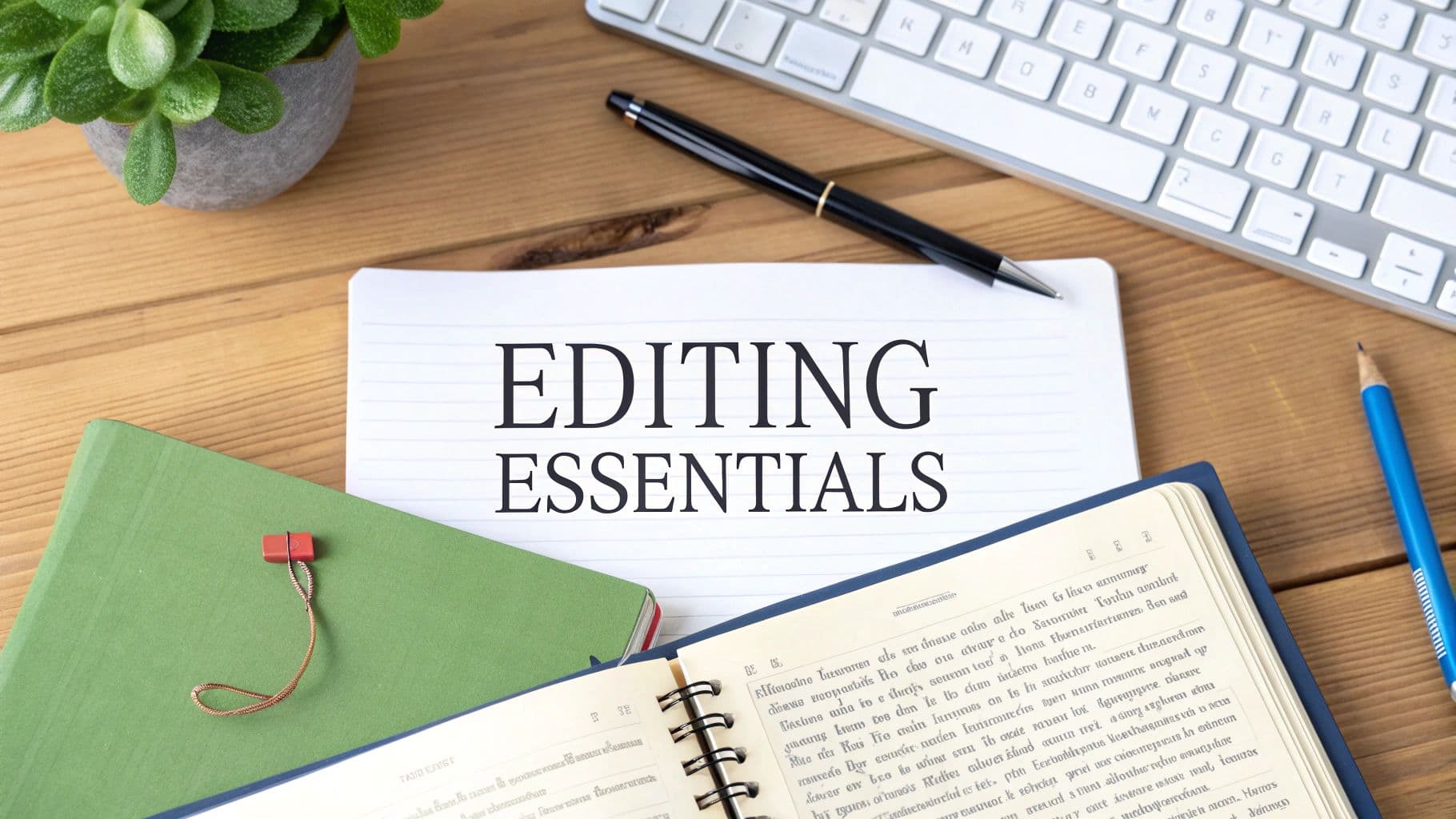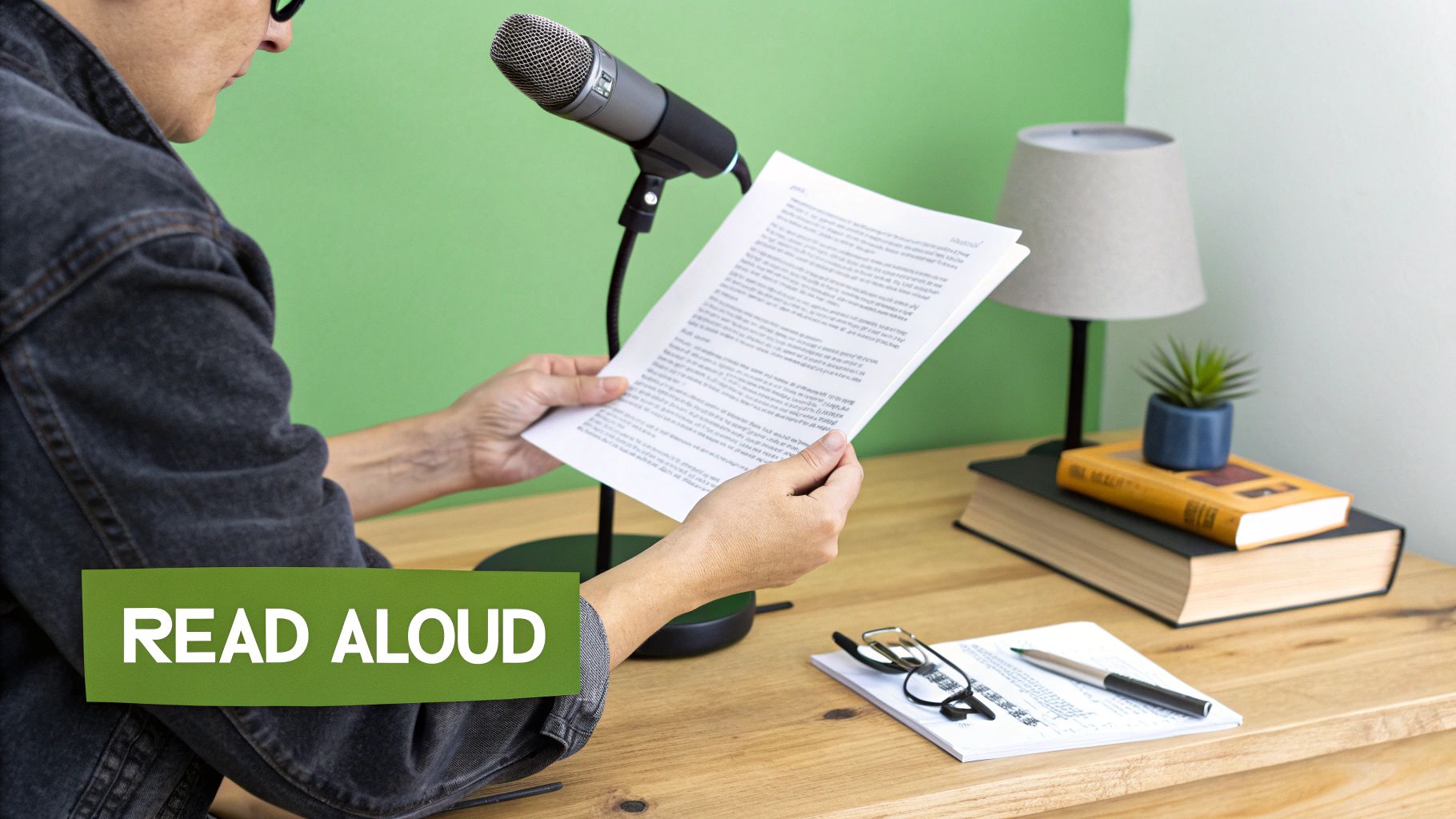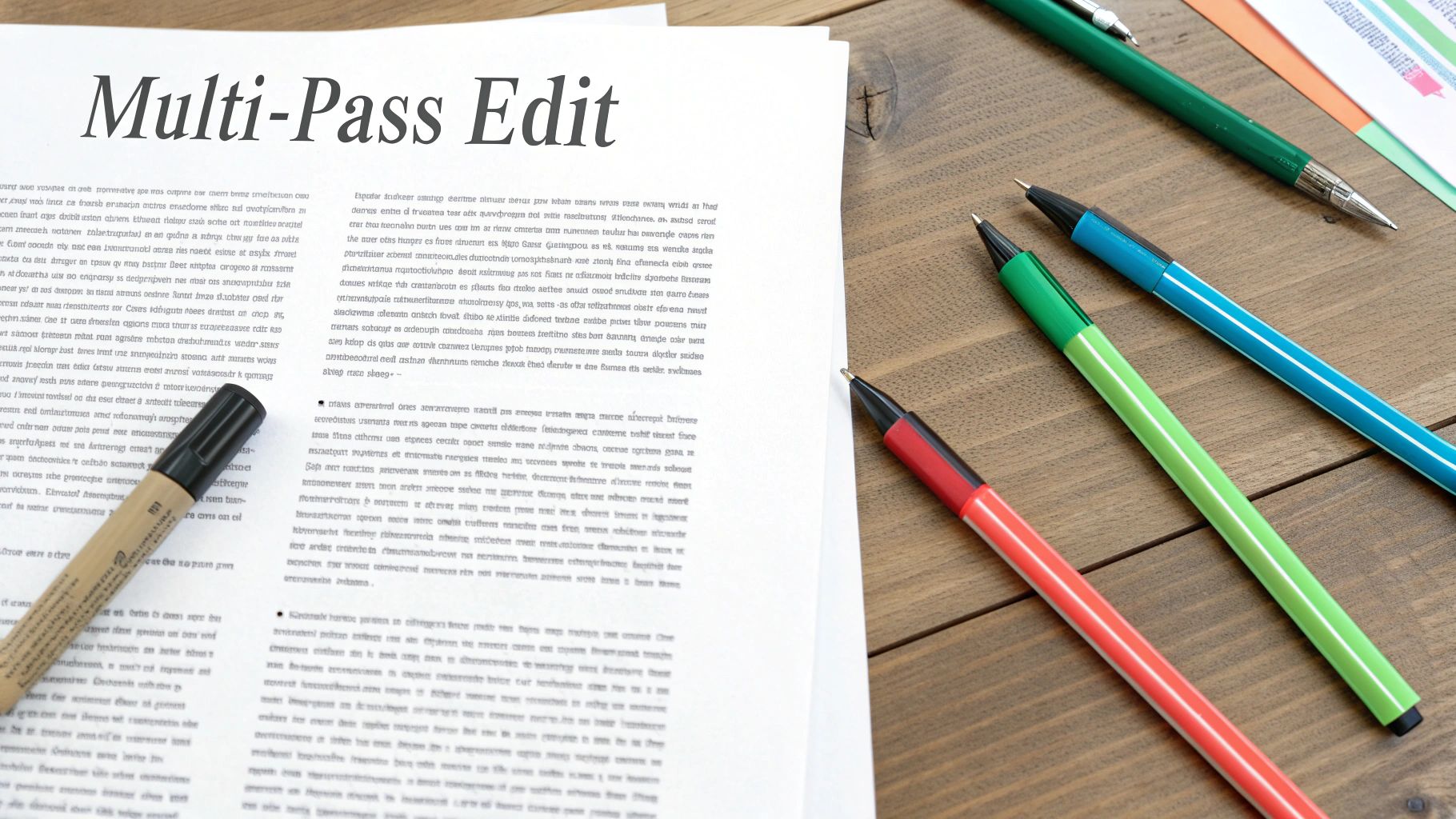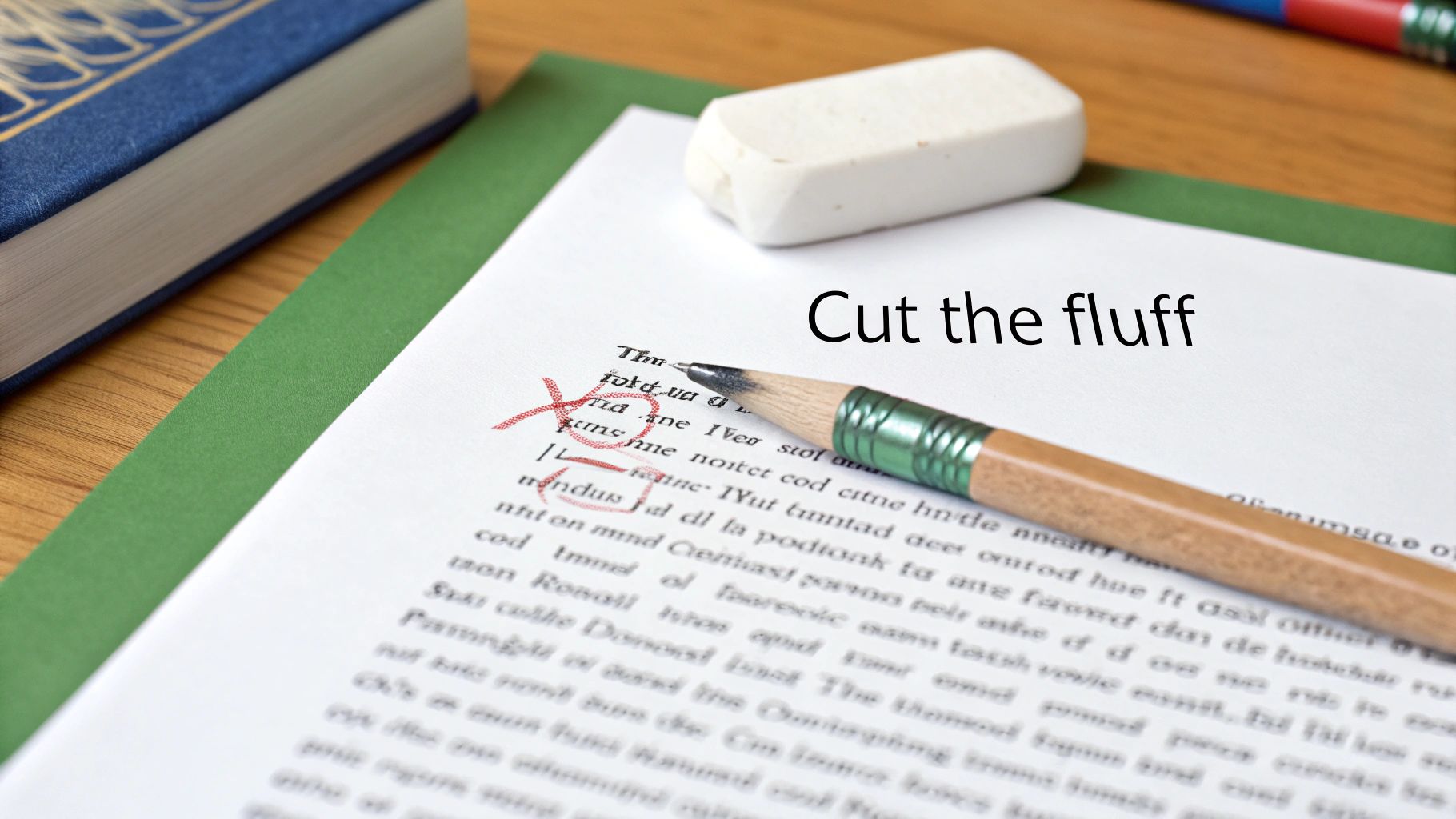
7 Essential Essay Editing Tips for 2025
June 26, 2025
Transforming a solid first draft into a polished, high-impact essay is the critical final step that separates good writing from great writing. Many students and professionals, after pouring hours into research and composition, often rush the editing process. This haste means missing crucial opportunities to elevate their work and make a lasting impression. This is precisely where a strategic approach to editing makes all the difference.
In this guide, we move beyond basic 'check for typos' advice to provide seven advanced essay editing tips. These actionable techniques are designed to help you refine your argument, enhance clarity, improve narrative flow, and ensure your final submission is as powerful as your initial ideas. We will cover specific methods like reverse outlining to check structure and the read-aloud technique to catch awkward phrasing.
Whether you're aiming for a better grade, a more persuasive professional document, or simply developing stronger writing skills, these methods will equip you to edit with confidence and precision. Furthermore, for those utilizing AI writing assistants to brainstorm or structure initial ideas, we will touch on how to humanize your final draft using tools like Natural Write to ensure it meets academic integrity standards and bypasses AI detection.
1. The Cooling-Off Period
One of the most powerful yet simple essay editing tips is to deliberately step away from your draft. The cooling-off period is a strategic pause between writing and editing. This intentional waiting time creates the cognitive and emotional distance necessary to review your work with fresh eyes, transforming you from a defensive writer into an objective editor. When you are deeply immersed in the writing process, you are often too close to the text to spot awkward phrasing, logical gaps, or even simple typos.

The psychological principle is simple: time allows your brain to reset. You forget the exact sentence structure you labored over, enabling you to see what is actually on the page, not what you meant to put there. This method is championed by professional writers across genres.
As Stephen King advises in his book On Writing: A Memoir of the Craft, "The shorter the book, the shorter the rest period." He recommends letting a manuscript rest for a minimum of six weeks to gain critical perspective.
While a student or professional on a deadline may not have six weeks, the core principle is scalable. An academic writer might finish a research paper draft a week before its due date, using the intervening time to prepare for other classes. Similarly, a journalist might complete a feature story draft and then switch to covering daily news, returning to the feature with a renewed, critical mindset.
How to Implement the Cooling-Off Period
To make this technique work for you, a little planning goes a long way. The goal is to build this pause directly into your writing workflow.
- For Short Essays (under 1,500 words): Plan for a minimum of 24 to 48 hours between finishing your draft and starting your edits.
- For Longer Papers or Reports: Aim for a longer break, ideally four days to a week. This gives you enough time to truly detach from the content.
- Use Calendar Reminders: Don't leave it to chance. When you finish your draft, immediately schedule a specific time to begin editing. This creates a firm commitment.
- Read It Aloud: When you return to your essay, read it aloud. This forces you to slow down and helps you catch clunky sentences and rhythmic errors your eyes might otherwise skim over.
2. Read Aloud Technique
One of the most transformative essay editing tips is to simply read your draft aloud. The read aloud technique forces you to slow down and engage with your text on an auditory level, making it one of the best ways to catch errors that your eyes might miss. When you read silently, your brain often automatically corrects mistakes, fills in missing words, and glides over awkward phrasing. Reading aloud, however, bypasses this mental shortcut and reveals how your words actually sound.

This method is incredibly effective at identifying clunky sentences, poor rhythm, and unclear transitions. If you find yourself stumbling over a phrase or running out of breath in the middle of a sentence, it is a clear sign that the sentence needs to be rewritten. The auditory feedback makes abstract issues like "flow" and "tone" tangible and easier to fix.
As acclaimed author Maya Angelou emphasized throughout her career, "I write and then I read it aloud, and that's the first edit." She believed that hearing the music and rhythm of the language was essential to crafting powerful prose.
This principle is widely applied in professional communication. TED Talk speakers rehearse their scripts aloud countless times to ensure clarity and impact, while radio hosts and podcasters do table reads to refine their segments. Even legal documents are sometimes read aloud to detect ambiguities that could cause issues later.
How to Implement the Read Aloud Technique
To get the most out of this powerful editing method, be deliberate in your approach. The goal is to create an objective auditory review of your work.
- Read Slowly: Don't rush. Read at a measured pace, pronouncing each word clearly. This helps you notice every comma, period, and word choice.
- Mark Problem Spots: Keep a pen or your cursor handy. When you stumble, hesitate, or feel a sentence is awkward, mark it immediately. Don't try to fix it on the spot; just identify the areas that need revision.
- Record Yourself: Use your phone to record yourself reading the essay. Listening to the playback provides another layer of detachment, making it even easier to hear clunky phrasing and rhythmic errors.
- Pay Attention to Punctuation: Your natural pauses for breath should align with your punctuation. If you are gasping for air in a long sentence, it likely needs to be broken up or restructured. For more insights on sentence structure, explore these effective writing strategies.
3. Reverse Outlining
Reverse outlining is a powerful diagnostic tool that flips the traditional writing process on its head. Instead of creating an outline before you write, you build one from your finished draft. This technique forces you to confront the actual structure of your essay, rather than the one you intended to create. By distilling each paragraph down to its core idea, you can objectively assess the logical flow, identify redundancies, and spot any arguments that have gone astray.

This method moves you from writer to architect, giving you a blueprint of your existing work. It’s one of the most effective essay editing tips for seeing your argument from a high-level perspective, making it easier to pinpoint structural weaknesses that are invisible when you’re immersed in the sentence-level details.
As composition and rhetoric instructors often teach, reverse outlining reveals the "bones" of your essay. It separates what the essay says from what you wanted it to say, providing a clear path for revision.
The technique is widely used in various professional and academic contexts. For instance, a graduate student might use a reverse outline to ensure each chapter of their dissertation logically builds upon the last. Similarly, a business writer can use it to check that a complex report flows coherently from problem to solution, ensuring stakeholders can follow the main points without getting lost.
How to Implement Reverse Outlining
This technique is most effective when done systematically. The goal is to create a concise, accurate map of your draft as it currently exists.
- Summarize Each Paragraph: Go through your draft and, in the margins or a separate document, write a single sentence or a 3-5 word phrase that captures the main point of each paragraph.
- Analyze the Flow: Read your list of summaries from top to bottom. Does the argument progress logically? Are there any jarring jumps or repetitive points? This is where structural problems become obvious.
- Identify Misfits and Gaps: Look for paragraph summaries that don't directly support your thesis. These paragraphs may need to be cut, moved, or rewritten to serve the essay's central purpose.
- Check for Cohesion: Use your new outline to see if paragraphs could be combined to strengthen a single point or split if they are trying to do too much at once. You can even reorder the paragraph summaries to find a more compelling sequence before moving any text in your draft.
4. The Multiple-Pass Method
Attempting to catch every type of error in a single read-through is a recipe for missed mistakes. The multiple-pass method is a systematic approach to editing where you read your essay several times, each time with a different, specific focus. This strategy prevents the cognitive overload that comes from hunting for high-level structural issues and low-level punctuation errors simultaneously, making it one of the most effective essay editing tips for ensuring a thorough review.

This compartmentalized approach allows your brain to concentrate fully on one aspect of the writing at a time, leading to a more polished final product. It transforms editing from a chaotic treasure hunt into an organized, layer-by-layer refinement process.
As famously practiced in professional newsrooms, no important story goes to print without multiple editing passes. One editor checks for factual accuracy, another for structure and flow, and a final proofreader scours for grammatical errors, ensuring quality at every level.
This method is highly scalable. A professional copy editor uses it to refine a book manuscript, a technical writer applies it to ensure clarity in complex documentation, and a student can use it to elevate a standard five-paragraph essay into a compelling, well-argued piece. The core principle is breaking a complex task into manageable parts.
How to Implement the Multiple-Pass Method
To execute this strategy effectively, you must be disciplined in what you look for during each pass. Take short breaks between each one to reset your focus.
- Pass 1: The Big Picture: Read exclusively for structure and argument. Does your thesis hold up? Is the logic sound? Do the main points flow in a coherent order? Ignore grammar and spelling completely.
- Pass 2: Paragraph Cohesion: Zoom in on each paragraph. Does each one have a clear topic sentence? Do the supporting sentences directly relate to that topic? Check for smooth transitions between paragraphs.
- Pass 3: Sentence-Level Polish: Now, focus on the sentences themselves. Look for clarity, conciseness, and variety. Are there awkward phrases or run-on sentences? Can you combine short, choppy sentences for better rhythm?
- Pass 4: The Final Proofread: This last pass is for the details. Meticulously check for grammar, spelling, punctuation, and formatting errors. Reading the essay backward, sentence by sentence, can help you spot typos your brain might otherwise auto-correct.
5. Paragraph Unity and Coherence Check
One of the most fundamental essay editing tips is to analyze your paragraphs for unity and coherence. This technique involves examining each paragraph to ensure it has a single, clear focus (unity) and that its sentences flow together logically (coherence). A unified paragraph develops one central idea, while a coherent paragraph connects those sentences smoothly, guiding the reader effortlessly from one point to the next.
This check transforms a collection of related sentences into a powerful, persuasive unit of thought. When you are deep in the writing process, it’s easy to stray from your main point or to assume connections are clear when they are not. Stepping back to assess each paragraph individually is crucial for building a strong, logical argument.
Composition experts often emphasize the "one paragraph, one idea" rule. Writing programs and classical rhetoric have long taught that a paragraph's strength lies in its ability to explore a single concept thoroughly before moving on.
This principle is vital across different writing disciplines. In academic writing, for instance, each paragraph in a literature review might dissect a specific study. In business communications, a proposal's paragraphs must present distinct benefits or features to avoid confusing the client. This focused approach ensures your message is received with maximum clarity. For more details on this, you can learn more about crafting well-structured paragraphs in our academic writing style guide.
How to Implement the Paragraph Unity and Coherence Check
To apply this check effectively, you need a systematic way to dissect and evaluate each paragraph in your essay.
- Isolate the Main Idea: Read a paragraph and try to summarize its core point in a single sentence. If you can't, the paragraph likely lacks unity and may be trying to cover too much ground.
- Check for Relevance: Once you have the main idea, review every sentence in the paragraph. Does each one directly support, explain, or provide evidence for that single idea? Delete or move any sentences that don't.
- Strengthen the Topic Sentence: The first sentence should ideally announce the paragraph's purpose. Make sure your topic sentence acts as a clear signpost for the reader.
- Improve the Flow: Read the paragraph aloud to check for coherence. Use transitional words and phrases (like "however," "therefore," or "in addition") to create logical bridges between sentences and ensure a smooth reading experience.
- Assess Its Role: Finally, ask yourself if the paragraph as a whole contributes meaningfully to your essay's overarching thesis. Every paragraph should be a vital step in advancing your main argument.
6. Sentence Variety and Flow Analysis
One of the most effective essay editing tips for elevating prose from good to great is analyzing sentence variety and flow. This technique involves deliberately examining the length, structure, and rhythm of your sentences. The goal is to avoid monotony and create a more dynamic, engaging reading experience by consciously combining short, punchy statements with longer, more descriptive ones. When every sentence follows the same pattern, the reader's attention wanes, but varied rhythms keep them engaged and help emphasize key ideas.
This principle is a cornerstone of powerful writing. A short, impactful sentence following a long, complex one can deliver a powerful punch. Conversely, a series of short, choppy sentences can create a sense of urgency or simplicity. This control over rhythm separates amateur writing from professional prose.
As famously advised in Strunk and White's The Elements of Style, "Vary the structure of your sentences. The ear demands variety." This timeless advice highlights that sentence structure is as much about sound and rhythm as it is about grammar.
This technique is visible everywhere. A speechwriter like those who worked with Barack Obama uses short, declarative sentences for applause lines, while a marketing copywriter uses a mix of sentence lengths to guide a reader through a sales page. Similarly, an academic writer must balance long, complex sentences that explain intricate theories with shorter ones that state a clear conclusion, making dense material more digestible.
How to Implement Sentence Variety and Flow Analysis
Integrating this analysis into your editing process requires a methodical approach. The aim is to consciously craft rhythm rather than letting it happen by chance.
- Count the Words: As a simple diagnostic, count the words in five or six consecutive sentences. If they are all within a few words of each other (e.g., 12, 14, 13, 15), your rhythm is likely monotonous.
- Check Sentence Beginnings: Scan your paragraphs for sentences that start with the same word or phrase (e.g., "The study found...", "The results showed..."). Varying the opening words is a quick way to improve flow.
- Combine and Break Up: Identify short, choppy sentences and see if they can be combined into a more sophisticated, complex sentence. Conversely, find long, rambling sentences and break them into two or more clearer, more direct ones.
- Read It Aloud: This is the ultimate test. Reading your essay aloud forces you to hear the rhythm. You will instantly notice where the flow is smooth and where it becomes clunky, awkward, or boring.
7. Eliminate Wordiness and Redundancy
A critical essay editing tip for enhancing clarity and impact is to systematically eliminate wordiness. This technique involves trimming unnecessary words, phrases, and repetitive ideas that clutter your prose without adding substantive value. Effective writing is concise; it communicates its message directly and powerfully. Wordiness weakens your argument by burying it in fluff, forcing your reader to work harder to grasp your point.
This principle of linguistic economy is about making every word justify its existence. When you cut redundant expressions, verbose constructions, and needless qualifiers, your core message shines through with greater force. This isn't just about shortening your essay; it's about sharpening it.
As William Strunk Jr. and E.B. White famously urged in The Elements of Style, "Vigorous writing is concise. A sentence should contain no unnecessary words, a paragraph no unnecessary new ideas, for the same reason that a drawing should have no unnecessary lines and a machine no unnecessary parts."
This advice is essential in professional and academic contexts where clarity is paramount. A grant proposal, for instance, must convey complex ideas within strict word counts, making conciseness a necessity. Likewise, business communications prioritize efficiency, and academic abstracts must pack maximum information into a minimal space. Tightening your language is a universal sign of strong writing.
How to Eliminate Wordiness and Redundancy
Adopting a "less is more" mindset is key. During your editing pass, actively hunt for words and phrases that can be removed without changing your meaning.
- Target Common Phrases: Replace lengthy phrases with single words. For example, change "due to the fact that" to because, "in order to" to to, and "at this point in time" to now.
- Remove Redundant Pairs: Watch for phrases where words mean the same thing, such as "first and foremost," "each and every," or "unexpected surprise." Choose one and move on.
- Strengthen Verbs: Swap weak verb and adverb combinations for a single, powerful verb. Instead of "walked very slowly," use ambled or shuffled. Instead of "very quickly ran," use sprinted.
- Cut Filler and Qualifiers: Remove filler phrases like "it is important to note that" or "as a matter of fact." Also, question qualifiers like "quite," "rather," and "somewhat," as they often dilute your statements.
- Use the Active Voice: The active voice is typically more direct and concise than the passive voice. "The team made a decision" is stronger than "A decision was made by the team." To discover more ways to refine your writing, you can learn more about how to improve writing on naturalwrite.com.
7 Essential Essay Editing Tips Compared
| Technique | Implementation Complexity 🔄 | Resource Requirements ⚡ | Expected Outcomes 📊 | Ideal Use Cases 💡 | Key Advantages ⭐ |
|---|---|---|---|---|---|
| The Cooling-Off Period | Low ⬇️ | Time only ⏳ | Increased objectivity and better flaw detection | All writers with flexible deadlines | Enhances editing effectiveness by mental distancing |
| Read Aloud Technique | Low to moderate 🔄 | Quiet space or recording device 🎙️ | Immediate identification of awkward phrasing and errors | Scripts, speeches, essays of any length | Reveals rhythm, flow, and grammar issues effectively |
| Reverse Outlining | Moderate 🔄 | Analytical skill, time ⏳ | Clear insight into essay structure and logical flow | Longer essays, research papers, reports | Identifies structural weaknesses and redundancies |
| The Multiple-Pass Method | High 🔄 | Significant time and discipline | Thorough, focused editing with minimized oversight | Complex or important documents | Comprehensive coverage without cognitive overload |
| Paragraph Unity and Coherence Check | Moderate 🔄 | Analytical focus | Improved readability with clear, focused paragraphs | Academic papers, business writing | Strengthens argument and clarity within paragraphs |
| Sentence Variety and Flow Analysis | Moderate 🔄 | Time, grammatical knowledge | More engaging, sophisticated, and readable prose | Literary works, speeches, marketing copy | Enhances reader engagement through rhythm and variety |
| Eliminate Wordiness and Redundancy | Moderate 🔄 | Multiple editing passes | Clear, concise writing respecting reader's time | Proposals, abstracts, social media | Tightens prose for clarity and impact |
Bringing It All Together for a Flawless Finish
Mastering the art of essay editing is a transformative journey, not a final destination. By moving beyond a simple spell check and incorporating the seven powerful techniques we've explored, you can systematically elevate your work. You are no longer just correcting mistakes; you are sculpting your ideas, ensuring they connect with your reader with precision and power. This deliberate, multi-faceted approach is what separates a good draft from a truly exceptional, polished piece of writing.
The strategies covered in this guide, from the essential "Cooling-Off Period" to the detailed "Sentence Variety and Flow Analysis," are not just isolated tricks. They are interconnected parts of a holistic editing system. Reading your work aloud makes structural flaws obvious, which you can then diagnose and fix using the Reverse Outlining method. The Multiple-Pass Method ensures you focus on one aspect at a time, preventing cognitive overload and leading to a more thorough review. These are the essay editing tips that build a foundation for powerful communication.
The True Value of Meticulous Editing
Why invest so much effort into this final stage? Because effective editing is a direct reflection of clear thinking. It demonstrates respect for your reader's time and a commitment to conveying your message without ambiguity. Whether you are a student aiming for a top grade, a marketer crafting a persuasive campaign, or a blogger building an audience, your ability to refine your writing is a critical skill. It proves you can not only generate ideas but also present them in their most compelling and coherent form.
Remember, the goal is not just to produce a grammatically correct document. The goal is to create a piece that is:
- Impactful: Your main arguments land with force and clarity.
- Cohesive: Ideas flow logically from one to the next, guiding the reader effortlessly.
- Engaging: Varied sentence structures and precise word choices keep the reader interested.
Navigating the Modern Writing Landscape
In today's academic and professional environments, where AI writing assistants are increasingly common, the human touch in editing has become more crucial than ever. After applying these foundational structural and stylistic edits, the final polish is what makes your voice unique. It's how you ensure your work sounds authentically human and aligns with your personal style.
By integrating these proven manual techniques with smart, ethical technology, you are demonstrating a sophisticated command of the writing process. You are not just submitting an assignment or publishing a post; you are showcasing a mastery of critical thinking and communication that will serve you well in every future endeavor. Take these essay editing tips, make them your own, and watch your writing reach new heights.
Ready to give your essay that final, professional polish? After applying these manual editing techniques, run your text through Natural Write to refine your tone, enhance clarity, and ensure your writing sounds authentically human. Perfect your prose and check for AI-generated patterns with one simple tool at Natural Write.


